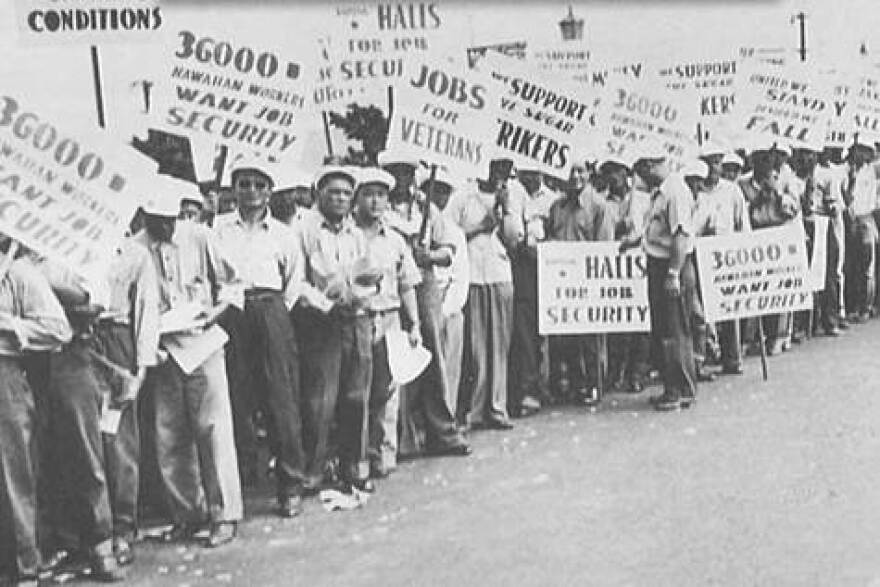
Hawaii State Archives
Laborers make demands on Kaua'i during the 1946 Sugar Strike.
Hawaii’s 28,000 sugar workers were struggling to bring dignity and fairness to their working lives by organizing into a union, the International Longshoremen’s and Warehousemen’s Union (ILWU) Local 142.
In 1946, on Labor Day, the union launched the strike that would change the course of labor nrelations and brought Hawaii into the modern era.
“In Hawai'i, these plantations exercised what has really been described to a lot of people as 'feudalistic' control over workers,” says William Puette, Director of the Center for Labor Education and Research at the University of Hawai'i – West O'ahu, “And there were lots of strikes that were attempted and failed for a variety of reasons. And this was really considered to be the first successful strike that was very well organized.”
While the plantation owners reaped fabulous wealth from the $160 million annual sugar and pineapple crop, workers earned 24-cents an hour.
The plantations devised a system of labor control after ruthlessly breaking attempts by three generations of sugar workers to improve their wages and conditions. The plantations learned to divide workers by recruiting different nationalities -- Chinese, Japanese, Korean and Filipino -- housing them in separate plantation camps and then pitting them against each other.
“It was advantageous to have on your plantation groups from different ethnicities so that if one of them got it in their mind to strike that you would still be able to get things done by the other groups,” says Puette, “That obviously, they didn’t admit to this but it laid the groundwork for them to be able to have one group pitted against the other by making sure that they didn’t play well together.”
Workers were kept on the plantations through wages and by creating a dependency on plantation controlled stores, housing, medical clinics, and social facilities.

Hawaii State Archives
Chinese laborers on a sugar plantation in 19th Century Hawaii
William Puette is the Director of the Center for Labor Education and Research at the University of Hawai'i – West O'ahu. Sugar plantations began operating in the early 1800s. Because it was labor intensive, plantation owners began importing overseas labor. First with the Chinese then the Japanese, Korean, and later Filipino.
While the plantation owners reaped fabulous wealth from the $160 million annual sugar and pineapple crop, workers earned 24 cents an hour. The plantations devised a system of labor control after ruthlessly breaking attempts by three generations of sugar workers to improve their wages and conditions. The plantations learned to divide workers by recruiting different nationalities and housing them in separate plantation camps.
The sugar workers also learned lessons from the past. By the 1940s, Japanese and Filipino sugar laborers dominated the plantation workforce.
The union united the different ethnic groups by actively fighting racial discrimination and recruiting leaders from each group. Members were kept informed and involved through a democratic union structure that reached into every plantation gang and plantation camp. At each meeting, translators kept the workers informed in Japanese, and the Filipino dialects of Ilocano and Visayan.
After three months, plantation owners agreed to union terms that included higher wages and a ban on foreign contract labor.

Hawaii State Archive
Sugar workers on Big Island. The 1946 strike was seen as the first successful
challenge to plantation power.
“The politics of Hawai'i would never be the same after that. And certainly labor relations would not be the same after that,” Puette told Hawaii Public Radio.
The power of unionization and this new found knowledge changed the lives of 28,000 sugar workers and their families. A year later, the struggle spread to involve 20,000 pineapple workers and thousands of their family members. The union movement had spread too far and too wide to ever be contained again.
The plantation stranglehold on Hawaii’s economy and social life was ended, and this opened the way for Hawaii to develop into a modern, democratic society.
EDITOR'S NOTE: For additional commentary, news and views from an AANHPI perspective, follow @DioknoEd on Twitter.
No comments:
Post a Comment